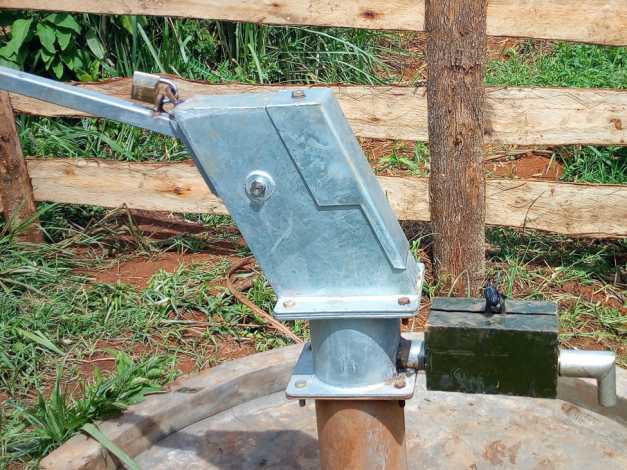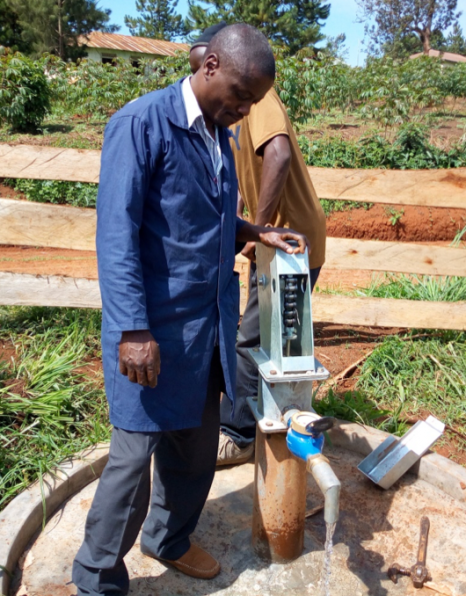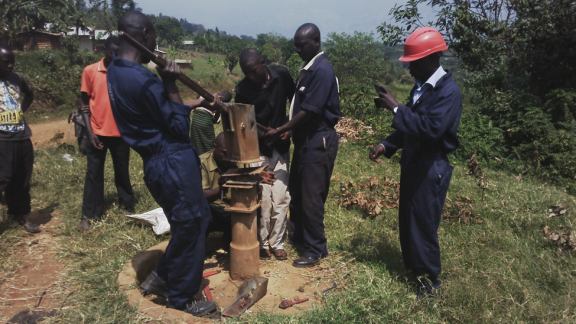Published on: 29/12/2017
The daunting challenge of collecting user fees or tariffs on communally managed water sources has called for innovations in many parts of Uganda. 'Pay-as-you-fetch' is one of the innovative approaches that has been adopted in Midwestern Uganda to ensure collection of fees for operation and maintenance and thus sustainability of water sources. 'Pay-as-you-fetch' is a method where a caretaker or operator of a hand pump collects money for water on a pay-as-you-fetch basis, and part of that collected revenue is applied to maintain water systems, increasing the sustainability. It is an old method for piped water systems operating public tap stands or water kiosks. The 'pay-as-you-fetch' model is mainly for hand pumps under community management.

The method was introduced by Water for People in Kamwenge and has since been adopted in Kabarole. A number of WASH implementers from within Uganda and from other countries are interested in learning about this sustainable solution. As Kabarole district local government and other development partners seek to embrace 'pay-as-you-fetch', the following checklist is produced to simplify the process. This is more of a practice note or a how-to guide on effective adoption and implementation of the model. It is based on implementation experiences and key motivations that make the system work.
Critical steps include:
A: Identification and selection of targeted hand pumps and communities to adopt the approach
- Suitable hand pumps are often those that have failed under the traditional community management system driven by voluntarism and nonpayment of tariffs.
- A sizeable number of users who would create adequate demand of at least 50 jerry cans per day. This is determined by asking the number of households and other potential users like schools that the hand pump serves.
- Hand pumps that are close to settlements and can easily be accessed. These should be less susceptible to vandalism as they are not far from communities.
- Carry out both technical and social assessments; technical assessments often carried out by hand pump mechanics to ascertain the level of rehabilitation needed and the technical viability of the hand pump to continue serving. Social assessments relate to community WASH concerns and ability to pay for water.
B: Community mobilization and engagement
This is a critical stage at which failure and defects will manifest themselves in failure to implement the approach.
- The community must be contacted and engaged through their local leaders.
- The community should be helped to reflect on the challenges they face with the current system in order to create desire for change.
- Extension staff with the help of the hand pump mechanic should be involved to give technical guidance to the discussion. Participatory methods should be adopted and the voice of women should be encouraged. Political leaders like area councillors, chairpersons and women representatives should be present.
- A register of community members present should be drawn up and copies shared with local leaders.
- A commitment letter or MOU with the community accepting to adopt the system of pay-as-you-fetch should be drawn up. This should list the members present and should be acknowledged by the local authorities at sub county level.
- Health assistant with help of Village Health Team (VHT) should mobilize communities on sanitation and hygiene to ensure improvement in the whole village. Often a follow-up Mandona approach or home improvement campaign is used.
C: Setting of a tariff
The tariff or user fee should be set in full participation with the community. It should be adequate to cover the Capital Expenditure cost, Capital Maintenance costs, operation expenditure as well as expenditure. Issues considered under these costs are explained in the life-cycle costs for water or At What Cost tool for tariff setting.
- Tariff should be based on affordability and far less than other service providers.
- Fees should be collectively calculated with the community based on the estimated sales against the cost and the technology of the hand pump.
- Customize the At What Cost tool to be able to engage with the community on tariff setting.
D: Rehabilitation and hand pump modifications
Often, the hand pump put under pay-as-you-fetch is nonfunctional or partially functional. It will require full rehabilitation involving replacement of all parts with new ones.
- Rehabilitations should involve the community especially in verification of materials against shared Bills of Quantities.
- Full rehabilitation should be undertaken with new pipes, rods, head pump and cylinder replaced.
- Modify the water tank with two sockets and fix a multi-jet wet water meter. There should be provisions for protecting the meter.
- Modify the head pump with hooks to make it lockable and thus enable controlled use.
- A fence or protective wall should be fixed and grass should be planted around the hand pump as a measure of source protection.
E: Operation and management
The major motivation for pay-as-you-fetch is effective operation and maintenance. Political leaders should be involved in official commissioning.
- Establish, orient and register the Water User Committee (WUC). Members should be trained on their new role of appointing and managing a caretaker, financial management and collection of user views as well as dispute resolution.
- Support WUC to appoint the source caretaker for day-to-day operations. Source caretaker should have some level of education and be able to read and write. Should be a community person and residing near the water source.
- Register the Water User Committee as a community group at the sub county level - Community Development Officer (CDO) should help WUC in drafting a constitution list of members (water users).
- Establish management rules that should be followed in using the water point. For example time/schedules of fetching water, and hygiene among others.
- Caretaker and WUC should be trained on how to read the water meter.
F: Financial management
This involves basic financial management measures to ensure optimal collection and use of fees. Best practice is to ensure that revenue collected is not spent before being banked. All funds should be banked first, and transactions properly documented (recorded).
- Support the WUC to register and open a bank account at a nearby convenient financial institution. Commercial banks are more encouraged than SACCOs (savings and credit cooperatives).
- Establish percentages, amounts to be paid to the caretaker, the hand pump mechanic for servicing, the percentage or amount for repair and future replacement. It is recommended that:
- 20% of the monthly collections is kept in the bank (Escrow account for capital replacement after three years (rehabilitation), 20% goes to the monthly wages of the operator (caretaker).
- 20% is paid to Hand Pump Mechanics Association to assign an area mechanic to do a) Preventive maintenance every three month ; b) Major servicing after a year and c) Undertake adhoc repairs when needed.
- 10% is used to facilitate the Water User Committee supervision and community meetings to provide for accountability and address community concerns.
- 30% is used for saving for operations which includes buying spare parts and if saved, community at discretion of the WUC can use it as Village Savings and Loans Associations.
- Develop and provide simple record books for example sales ledger to the caretaker.
- Marketing methods including segmentation of users that can be used to ensure effective use.
G: Repairs and servicing
For the pay-as-you-fetch model to work, the hand pump must function efficiently. The major motivation of users to pay is to have a reliable, functional water source.
- WUC and Hand Pump Mechanics Association should have MOU or agreement on routine servicing and repairs. This should show schedule, who the assigned HPM is and the amount for each service.
- Caretaker and hand pump mechanic assigned to the borehole should be in close contact for immediate action in case of breakdown and also routine servicing.
- Ensure that routine servicing is scheduled and done at least once per quarter.
H: Post-rehabilitation of community support
The community development officer ensures the sustainability of the model.
- Support the WUC to fulfill its roles and provide accountability to the users whilst addressing community concerns. Water user meetings should involve the CDO.
- Monitoring progress of the hand pump. Financial tracking, usage tracking and functionality /reliability tracking.
- Documentation and sharing of human interest stories to motivate users, caretaker and WUC on the pay-as-you-fetch method.

Conclusion
This approach calls for close cooperation of key stakeholders in operation and maintenance of water systems in rural areas. These stakeholders are community leaders and committees, operators and entrepreneurs, financial institutions, hand pump mechanics, sub county extension staff and political leaders among others.
Compared to a monthly fee collection per household, or adhoc collection of funds for repair of the hand pumps when they break down, pay-as-you-fetch is an effective sustainability approach if adopted in a systematic manner.
"One of the most promising innovations in the rural water sector of Uganda is the pay-as-you-fetch model. It requires water users to pay for the water they use. The fees collected are used to sufficiently maintain the water point forever. As such, they never need intervention from any other agency. This reduces and eventually eliminates wasted investments for the many NGOs in the water and sanitation sector", says Diana Keesiga. Also see Five questions with Diana Keesiga.



